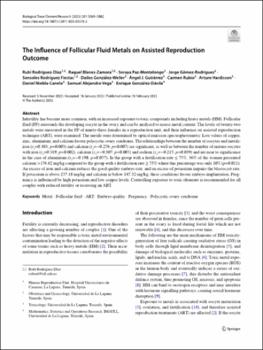The Infuence of Follicular Fluid Metals on Assisted Reproduction Outcome
Fecha
2023Resumen
Infertility has become more common, with an increased exposure to toxic compounds including heavy metals (HM). Follicular fuid (FF) surrounds the developing oocyte in the ovary and can be analysed to assess metal content. The levels of twenty-two
metals were measured in the FF of ninety-three females in a reproduction unit, and their infuence on assisted reproduction technique (ART), were examined. The metals were determined by optical emission spectrophotometry. Low values of copper,
zinc, aluminium, and calcium favour polycystic ovary syndrome. The relationships between the number of oocytes and metals: iron (rs=0.303; p=0.003) and calcium (rs=−0.276; p=0.007) are signifcant, as well as between the number of mature oocytes with iron (rs=0.319; p=0.002), calcium (rs=−0.307; p=0.003) and sodium (rs=−0.215; p=0.039) and are near to signifcance in the case of aluminium (rs=−0.198; p=0.057). In the group with a fertilisation rate ≤ 75%, 36% of the women presented calcium >176.62 mg/kg compared to the group with a fertilisation rate ≥ 75% where this percentage was only 10% (p=0.011). An excess of iron and calcium reduces the good quality embryo rate, and an excess of potassium impairs the blastocyst rate. If potassium is above 237.18 mg/kg and calcium is below 147.32 mg/kg, these conditions favour embryo implantation. Pregnancy is infuenced by high potassium and low copper levels. Controlling exposure to toxic elements is recommended for all
couples with reduced fertility or receiving an ART.






